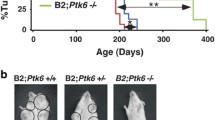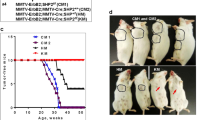Summary
A causative role of the membrane-bound tyrosine kinase ErbB-2 in breast tumorigenesis has been well established. MMTV/neu transgenic mice which overexpress ErbB-2 consistently develop mammary carcinomas with a high incidence. In human breast cancer, ErbB-2 is overexpressed in 25–30 of all cases and is representing a clinical marker of a poor prognosis. Besides to gene amplification, ErbB-2 overexpression has been attributed to transcription factors of the AP-2 family which were shown to control the ErbB-2 gene promoter in cell culture studies. Particularly AP-2α and γ are often coexpressed in ErbB-2-positive breast carcinomas. However, LTRγ transgenic mice which overexpress AP-2γ in their mammary epithelium display only a very weak upregulation of the erbB-2 gene and do not develop mammary carcinoma. These findings therefore raise the possibility of functional cooperativity between both genes in breast cancer. To experimentally address the impact of AP-2γon ErbB-2-induced breast carcinogenesis we crossed MMTV/neu transgenic mice with LTRγ transgenic mice and monitored tumor development in bitransgenic female progeny. AP-2γ overexpression negatively influenced tumor incidence, as reflected by a reduced tumor number and a prolonged tumor latency. Histological analysis revealed three major types of tumors corresponding to different stages of tumor progression. Interestingly, an increased proportion of advanced stage carcinomas was observed in bitransgenic mice. Moreover, the AP-2γ transgene differentially affected proliferation rates between the different progression stages: proliferation was enhanced at early stages but reduced in advanced stages in comparison to control tumors. Therefore, AP-2γ while reducing the incidence of mammary tumors is promoting tumor progression.
Similar content being viewed by others
References
K Hilger-Eversheim M Moser H Schorle R Buettner (2000) ArticleTitleRegulatory roles of AP-2 transcription factors in vertebrate development, apoptosis and cell-cycle control Gene 260 1–12
F Zhao M Satoda JD Licht Y Hayashizaki BD Gelb (2001) ArticleTitleCloning and characterization of a novel mouse ap-2 transcription factor, ap-2delta, with unique DNA binding and transactivation properties J Biol Chem 276 40755–40760
W Feng T Williams (2003) ArticleTitleCloning and characterization of the mouse AP-2 epsilon gene: a novel family member expressed in the olfactory bulb Mol Cell Neurosci 24 460–475
R Tummala RA Romano E Fuchs S Sinha (2003) ArticleTitleMolecular cloning and characterization of AP-2 epsilon, a fifth member of the AP-2 family Gene 321 93–102
LA McPherson VR Baichwal RJ Weigel (1997) ArticleTitleIdentification of ERF-1 as a member of the AP2 transcription factor family Proc Natl Acad Sci USA 94 4342–4347
JM Bosher T Williams HC Hurst (1995) ArticleTitleThe developmentally regulated transcription factor AP-2 is involved in c-erbB-2 overexpression in human mammary carcinoma Proc Natl Acad Sci USA 92 744–747
JM. Bosher NF Totty JJ Hsuan T Williams HC Hurst (1996) ArticleTitleA family of AP-2 proteins regulates c-erbB-2 expression in mammary carcinoma Oncogene 13 1701–1707
BC Turner J Zhang AA Gumbs MG Maher L Kaplan D Carter PM Glazer HC Hurst BG Haffty T Williams (1998) ArticleTitleExpression of AP-2 transcription factors in human breast cancer correlates with the regulation of multiple growth factor signalling pathways Cancer Res 58 5466–5472
T Holbro NE Hynes (2004) ArticleTitleErbB receptors: directing key signaling networks throughout life Annu Rev Pharmacol Toxicol 44 195–217
SA Eccles (2002) ArticleTitleThe role of c-erbB-2/HER2/neu in breast cancer progression and metastasis J Mammary Gland Biol Neoplasia 6 393–406
CT Guy MA Webster M Schaller TJ Parsons RD Cardiff WJ Muller (1992) ArticleTitleExpression of the neu protooncogene in the mammary epithelium of transgenic mice induces metastatic disease Proc Natl Acad Sci USA 89 10578–10582
WJ Muller E Sinn PK Pattengale R Wallace P Leder (1988) ArticleTitleSingle-step induction of mammary adenocarcinoma in transgenic mice bearing the activated c-neu oncogene Cell 54 105–115
L Bouchard L Lamarre PJ Tremblay P Jolicoeur (1989) ArticleTitleStochastic appearance of mammary tumors in transgenic mice carrying the MMTV/c-neu oncogene Cell 57 931–936
ER Andrechek WR Hardy PM Siegel MA Rudnicki RD Cardiff WJ Muller (2000) ArticleTitleAmplification of the neu/erbB-2 oncogene in a mouse model of mammary tumorigenesis Proc Natl Acad Sci USA 97 3444–3449
KL Troyer DC Lee (2001) ArticleTitleRegulation of mouse mammary gland development and tumorigenesis by the ERBB signaling network J Mammary Gland Biol Neoplasia 6 7–21
NP Bates HC Hurst (1997) ArticleTitleTranscriptional regulation of Type I receptor tyrosine kinases in the mammary gland J Mammary Gland Biol Neoplasia 2 153–163
HC Hurst (2001) ArticleTitleUpdate on HER-2 as a target for cancer therapy. The ERBB2 promoter and its exploitation for cancer treatment Breast Cancer Res 3 395–398
V Perissi N Menini E Cottone D Capello M Sacco F Montaldo M Bortoli ParticleDe (2000) ArticleTitleAP-2 transcription factors in the regulation of ERBB2 gene transcription by oestrogen Oncogene 19 280–288
D Vernimmen D Begon C Salvador S Gofflot M Grooteclaes R Winkler (2003) ArticleTitleIdentification of HTF (HER2 transcription factor) as an AP-2 (activator protein-2) transcription factor and contribution of the HTF binding site to ERBB2 gene overexpression Biochem J. 370 323–329
JA Williamson (1996) ArticleTitleChromosomal mapping of the human and mouse homologues of two new members of the AP-2 family of transcription factors Genomics 35 262–264
C Zhao K Yasui CJ Lee H Kurioka Y Hosokawa T Oka J Inazawa (2003) ArticleTitleElevated expression levels of NCOA3, TOP1, and TFAP2C in breast tumors as predictors of poor prognosis Cancer 98 18–23
R Jäger U Werling S Rimpf A Jacob H Schorle (2003) ArticleTitleTranscription factor AP-2γ stimulates proliferation and apoptosis and impairs differentiation in a transgenic model Mol Cancer Res 1 921–929
B Li JM Rosen J McMenamin-Balano WJ Muller AS Perkins (1997) ArticleTitleneu/ERBB2 cooperates with p53–172H during mammary tumorigenesis in transgenic mice Mol Cell Biol. 17 3155–3163
JM Chirgwin AE Przybyla RJ MacDonald WJ Rutter (1979) ArticleTitleIsolation of biologically active ribonucleic acid from sources enriched in ribonuclease Biochemistry 18 5294–52999
N Munarini R Jäger S Abderhalden G Zuercher V Rohrbach S Loercher B Pfanner-Meyer AC Andres A Ziemiecki (2002) ArticleTitleAltered mammary epithelial development, pattern formation and involution in transgenic mice expressing the EphB4 receptor tyrosine kinase J Cell Sci. 115 25–37
RD Cardiff E Sinn W Muller P Leder (1991) ArticleTitleTransgenic oncogene mice. Tumor phenotype predicts genotype Am J Pathol 139 495–501
A Rosner K Miyoshi E Landesman-Bollag X Xu DC Seldin AR Moser CL MacLeod G Shyamala AE Gillgrass RD Cardiff (2002) ArticleTitlePathway pathology: histological differences between ErbB/Ras and Wnt pathway transgenic mammary tumors Am J Pathol 161 1087–1097
H Lazar A Baltzer C Gimmi A Marti R Jaggi (2000) ArticleTitleOver-expression of erbB-2/neu is paralleled by inhibition of mouse-mammary-epithelial-cell differentiation and developmental apoptosis Int J Cancer 85 578–5783
J Pellikainen A Naukkarinen K Ropponen J Rummukainen V Kataja J Kellokoski M Eskelinen VM Kosma (2004) ArticleTitleExpression of HER2 and its association with AP-2 in breast cancer Eur J Cancer 40 1485–1495
JM Gee JF Robertson IO Ellis RI Nicholson HC Hurst (1999) ArticleTitleImmunohistochemical analysis reveals a tumour suppressor-like role for the transcription factor AP-2 in invasive breast cancer J Pathol 189 514–520
J Pellikainen V Kataja K Ropponen J Kellokoski T Pietilainen J Bohm M Eskelinen VM Kosma (2002) ArticleTitleReduced nuclear expression of transcription factor AP-2 associates with aggressive breast cancer Clin Cancer Res 8 3487–3495
J Zhang S Brewer J Huang T Williams (2003) ArticleTitleOverexpression of transcription factor AP-2alpha suppresses mammary gland growth and morphogenesis Dev Biol 256 127–45
GJ Rowse SR Ritland SJ Gendler (1998) ArticleTitleGenetic modulation of neu proto-oncogene-induced mammary tumorigenesis Cancer Res 58 2675–2679
E Di Carlo MG Diodoro K Boggio A Modesti M Modesti P Nanni G Forni P Musiani (1999) ArticleTitleAnalysis of mammary carcinoma onset and progression in HER-2/neu oncogene transgenic mice reveals a lobular origin Lab Invest 79 1261–1269
Author information
Authors and Affiliations
Rights and permissions
About this article
Cite this article
Jäger, R., Friedrichs, N., Heim, I. et al. Dual role of AP-2γ in ErbB-2-induced mammary tumorigenesis. Breast Cancer Res Treat 90, 273–280 (2005). https://doi.org/10.1007/s10549-004-4815-x
Issue Date:
DOI: https://doi.org/10.1007/s10549-004-4815-x




